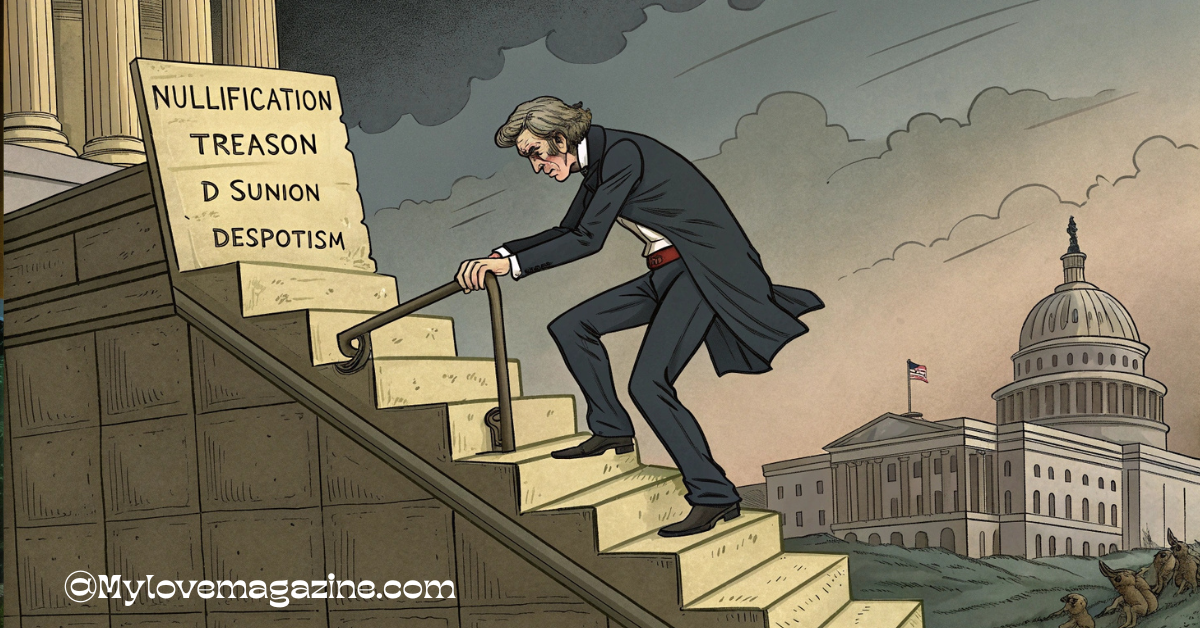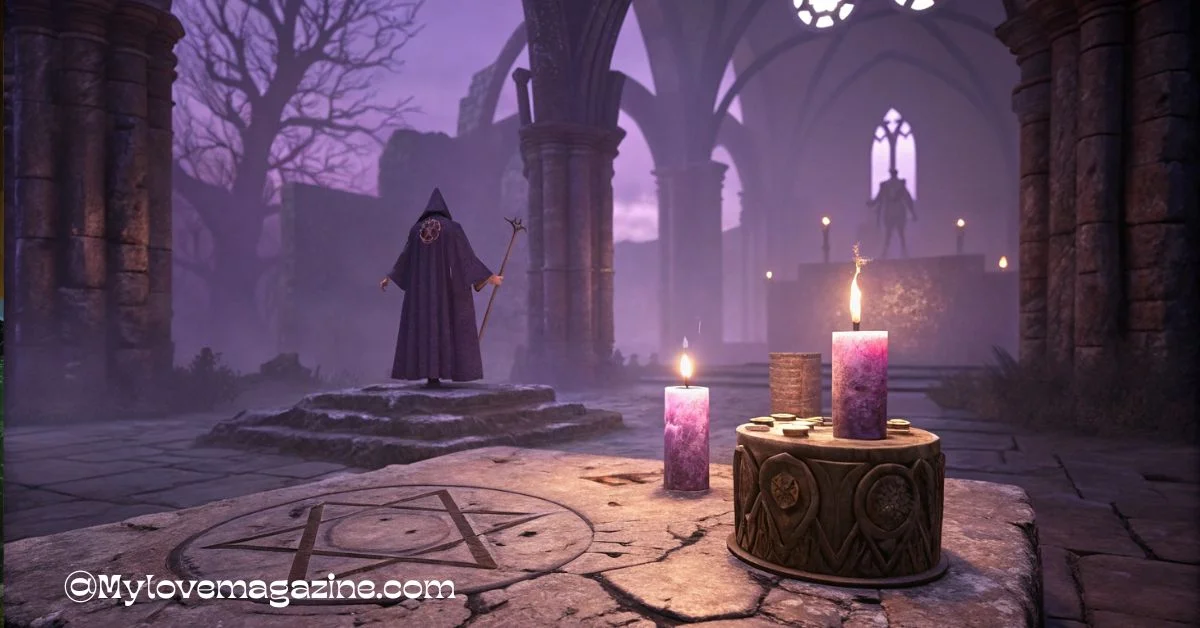Calhoun Climb to Despotism Cartoon Explained!
The Calhoun climb to despotism cartoon is a powerful 1830s political image showing John C. Calhoun ascending steps labeled “Nullification,” “Treason,” and “Disunion” toward “Despotism.” It visually critiques his pro-states’ rights stance during the Nullification Crisis. This cartoon remains a vital symbol in understanding the dangers of ideological extremism in American political history.
Stay tuned with us—we’ll continue exploring more powerful political cartoons like the “Calhoun climb to despotism cartoon,” uncovering how art shaped America’s political debates and national identity.
What Is the “Calhoun Climb to Despotism” Cartoon?
The “Calhoun climb to despotism cartoon” is one of the most well-known political cartoons from the early 19th century. Created during the intense political climate of the 1830s, this cartoon illustrated the perceived dangers of John C. Calhoun’s political philosophy, particularly his support for nullification. In the cartoon, Calhoun is shown ascending a staircase labeled with dangerous ideological steps like “Nullification,” “Treason,” and “Disunion,” ultimately reaching the pinnacle of “Despotism.”
This cartoon remains significant in American political history because it captures a visual representation of national anxiety about division, rebellion, and centralized power. It uses satire to warn of the perceived consequences of Calhoun’s actions and has become a lasting image used in discussions of federalism, states’ rights, and the road to the Civil War. It exemplifies how political cartoons served as persuasive tools long before social media or television, making complex issues understandable to a broad audience.
Who Was John C. Calhoun and Why Was He Climbing Toward “Despotism”?
John C. Calhoun was a prominent American politician from South Carolina who served as Vice President under both John Quincy Adams and Andrew Jackson. He was also a U.S. Senator, Secretary of War, and a leading intellectual voice in American politics. While initially a nationalist, Calhoun evolved into a strong advocate for states’ rights and limited federal government.
Calhoun’s support for the doctrine of nullification, which proposed that individual states had the right to reject federal laws they deemed unconstitutional, became the focal point of his controversial legacy. He argued that the federal government had overstepped its bounds, particularly with tariffs that hurt Southern economies. His opponents saw this stance as dangerously radical. They believed it opened the door to rebellion, disunion, and the undermining of the constitutional framework.
To critics, Calhoun was not just challenging policy but undermining the union itself. By climbing the metaphorical stairs to despotism, he appeared to be leading the South toward a path of division and authoritarianism, cloaked in the language of liberty and states’ rights.
What Was the Historical Context Behind the Cartoon?
The “Calhoun climb to despotism cartoon” must be understood within the context of the Nullification Crisis, which erupted in the early 1830s. This conflict arose when Southern states, especially South Carolina, strongly opposed the “Tariff of Abominations” passed in 1828. These tariffs placed high duties on imported goods, benefiting Northern manufacturers at the expense of Southern planters who relied on trade.
Calhoun, a native of South Carolina, emerged as a chief critic of the tariff. He anonymously authored the “South Carolina Exposition and Protest,” arguing that states had the right to nullify unconstitutional federal laws. This laid the ideological groundwork for a confrontation between South Carolina and the federal government.
The cartoon was created as a direct response to this crisis. It aimed to dramatize the slippery slope Calhoun’s ideology represented, from the rejection of federal authority to the complete breakdown of the Union. It illustrated the fear that nullification would lead not only to disunion but to autocratic rule, hence the ominous label of “Despotism” at the top of the staircase.
How Does the Cartoon Visually Represent the Path to Despotism?
The visual elements of the “Calhoun climb to despotism cartoon” are striking and intentional. At its core, the cartoon features John C. Calhoun climbing a staircase made up of increasingly dangerous ideological concepts: “Nullification,” “Treason,” “Disunion,” and finally “Despotism.” Each step represents a progression away from constitutional governance and toward tyranny.
Calhoun is typically portrayed with exaggerated features, a common trait in political cartoons, to emphasize arrogance or blindness. At the base of the stairs stands President Andrew Jackson or figures representing the Union, pulling at Calhoun’s leg or trying to stop his ascent. This symbolizes the federal government’s effort to restrain secessionist ambitions.
Other figures, such as Southern supporters or concerned Northerners, may appear in the cartoon expressing alarm, symbolizing the widespread anxiety about the implications of Calhoun’s actions. The imagery is rich with symbolism, portraying a dire warning against undermining the Union for political ideology.
Why Did Andrew Jackson Oppose Calhoun So Strongly?
Andrew Jackson, a staunch Unionist despite his Southern background, saw nullification as a direct threat to the integrity of the United States. While he had some sympathy for the South’s economic grievances, Jackson believed in the supremacy of federal law and the preservation of the Union at all costs.
In 1832, South Carolina declared the tariffs null and void within its borders, prompting Jackson to act. He issued a strong proclamation against nullification and worked with Congress to pass the Force Bill, which authorized the use of military force to enforce federal laws. Jackson’s response was not just political; it was personal. His rift with Calhoun deepened, fueled by both ideological differences and personal animosity.
This tension between the two leaders almost tore the country apart. Jackson’s fierce opposition helped prevent immediate disunion, but it also foreshadowed the deeper conflicts that would later erupt in the Civil War. The cartoon captures this power struggle, with Jackson portrayed as pulling Calhoun back from the brink.
How Did the Crisis End and What Was the Role of Compromise?
The Nullification Crisis reached its peak in 1833. With South Carolina refusing to enforce the federal tariffs and the federal government preparing to act militarily, the country stood on the edge of conflict. The crisis was ultimately diffused through the efforts of Senator Henry Clay, who brokered the Compromise Tariff of 1833.
This compromise gradually reduced the tariff rates over the next decade, satisfying many of the South’s economic concerns. In response, South Carolina rescinded its nullification of the tariffs but paradoxically issued a separate nullification of the Force Bill, maintaining its stance on states’ rights.
Though the immediate crisis was resolved, the deeper constitutional issue of state versus federal authority remained unresolved. The cartoon’s message about the dangers of undermining the Union continued to resonate, as the seeds of civil war had already been sown.
What Was the Public Reaction to the Cartoon at the Time?
In the 1830s, political cartoons were a popular medium for shaping public opinion, especially among the literate classes in urban centers. The “Calhoun climb to despotism cartoon” quickly gained traction as a powerful critique of the nullification doctrine.
Many viewers saw the cartoon as an accurate and alarming depiction of Calhoun’s ambitions. It reinforced the idea that rejecting federal authority would inevitably lead to chaos and tyranny. Southern supporters of Calhoun, however, viewed it as a smear campaign meant to delegitimize legitimate concerns over economic and political autonomy.
Overall, the cartoon served its purpose by engaging a politically active audience in a vivid, memorable way. It translated abstract political theory into a simple but potent visual narrative, which helped mobilize public support for federal authority.
How Is the “Calhoun Climb to Despotism” Cartoon Used Today?
Today, the “Calhoun climb to despotism cartoon” is frequently used in academic settings to illustrate the political tensions of the early 19th century. Teachers and historians use it as a tool to help students understand the complexities of the Nullification Crisis, the roots of the Civil War, and the enduring conflict between federal and state powers.
The cartoon also holds modern relevance. In an age of increasing polarization and debate over the limits of government power, it serves as a historical warning. It reminds us how easily passionate political ideals can escalate into threats to national unity. The cartoon remains a compelling artifact in discussions about democracy, federalism, and the responsibilities of elected leaders.
Are There Similar Political Cartoons from the Era?
Yes, the “Calhoun climb to despotism cartoon” was part of a broader tradition of political satire in early American history. Another notable example is the “King Andrew the First” cartoon, which depicted Andrew Jackson in monarchial attire, criticizing his use of presidential power. These cartoons used exaggeration and symbolism to challenge political authority and influence public opinion.
Such visual commentary played a vital role in American democracy by providing accessible critiques of powerful figures. They helped create an informed public that could engage with political debates even without access to formal education. The lasting impact of these cartoons is evident in how they continue to be cited in textbooks, lectures, and political discussions today.
What Can We Learn from the Calhoun Cartoon Today?
The “Calhoun climb to despotism cartoon” teaches us valuable lessons about the power of political imagery, the fragility of national unity, and the importance of maintaining constitutional balance. It shows how visual satire can expose dangerous ideologies and provoke critical thought.
Understanding historical cartoons like this one helps us interpret modern political movements and rhetoric more thoughtfully. As the U.S. continues to grapple with questions of governance, rights, and federal power, the lessons embedded in this cartoon remain strikingly relevant.
FAQ’s
1. What does the “Calhoun climb to despotism cartoon” represent?
It represents the perceived threat of John C. Calhoun’s nullification ideology, showing his ideas as a dangerous path to tyranny.
2. Why was nullification seen as so controversial?
Because it challenged federal authority and raised fears of secession and national disintegration.
3. Who created the cartoon, and when?
The cartoon was published anonymously during the 1830s in response to the Nullification Crisis, reflecting the sentiments of pro-Union Americans.
4. How do modern educators use this cartoon?
They use it to explain historical events like the Nullification Crisis and teach critical thinking about political propaganda.
5. Is the cartoon still relevant today?
Yes, it continues to offer insight into political conflict, power struggles, and the dangers of ideological extremism.
6. What is the political cartoon trying to suggest?
It suggests that Calhoun’s ideology could lead the country away from democracy and toward authoritarian rule, warning of the dangers of unchecked states’ rights.
7. What did the political cartoon about King Andrew mean?
The “King Andrew the First” cartoon depicted President Andrew Jackson as a tyrant abusing executive power, criticizing his disregard for the Constitution, and his aggressive use of vetoes.
Conclusion
The “Calhoun climb to despotism cartoon” remains one of the most powerful visual critiques in American history. It reflects a moment when the Union teetered on the edge of division and captures the ideological battle that shaped the nation’s future. By studying this cartoon, we gain not only historical knowledge but also timeless insight into the challenges of democracy, unity, and governance.












Post Comment